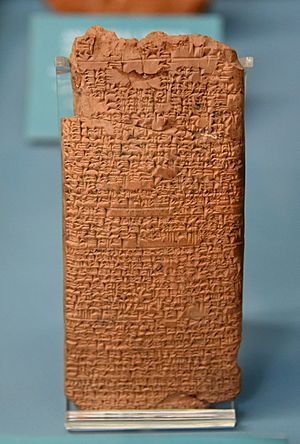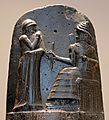Babylonia facts for kids
Quick facts for kids
Babylonia
|
|||||||||||
|---|---|---|---|---|---|---|---|---|---|---|---|
| 1895 BC – 1595 BC, and 605 BC - 539 BC | |||||||||||

|
|||||||||||
| Capital | Babylon | ||||||||||
| Official languages | |||||||||||
| Common languages | Akkadian Aramaic |
||||||||||
| Religion | Babylonian religion | ||||||||||
| History | |||||||||||
|
• Established
|
1895 BC | ||||||||||
|
• Disestablished
|
1595 BC, and 605 BC - 539 BC | ||||||||||
|
|||||||||||
| Today part of | |||||||||||
Babylonia, also known as the Babylonian Empire, was an important city-state in Mesopotamia over 3000 years ago. Its capital city was Babylon, which meant The Gate of the Gods. The Babylonians built a large empire from the lands of the earlier Akkadian empire.
Mesopotamia is a region between two big rivers, the Euphrates and the Tigris. Back then, it also included city-states like Assyria to the north and Elam to the south-east. This area is part of the Fertile Crescent in the Middle East. It was one of the first places where people lived together in a civilization. They started farming, built cities, and developed writing.
Contents
Life in Old Babylonia
The Babylonians had a written language they used for trade and sending messages. They learned it from the Sumerians, who invented it. The Babylonians used a system called cuneiform. This involved pressing triangular shapes into soft clay tablets. They wrote in two different languages: Sumerian for religious texts and Akkadian for official documents.
Hammurabi's Laws
Hammurabi was a famous king of Babylon. He fought many wars and made Babylonia into a powerful empire. He even made Assyria a vassal state, meaning it was controlled by Babylon. Hammurabi created one of the earliest written sets of laws, known as the Code of Hammurabi. This code has 280 rules and decisions. You can see it today at the Louvre museum in Paris. Unlike earlier Sumerian laws, Babylonian laws were very strict. For example, serious crimes like theft and murder had harsh punishments.
Babylonian Homes
Houses in Babylon often had open roofs. This allowed families to sleep there on hot nights to stay cool. Living rooms, dining rooms, and kitchens were usually downstairs. Lamps used olive oil for light. Every house also had a small chapel for family worship and burials. Since Mesopotamia had mostly clay for building, strong wooden supports for houses had to be brought in from Lebanon. Over time, people learned to bake their bricks, which made their buildings much stronger.
The Fall and Rise of Babylon
Later, the city of Babylon was attacked and damaged by the Hittite king Musilis I. This event led to a period known as the 'Dark Ages' of the Bronze Age, where there isn't much written information. Historians still debate the exact date when Babylon was attacked. Some possible dates are:
- 1499 BC
- 1531 BC
- 1595 BC
- 1651 BC
It's hard to match these dates with records from Ancient Egypt.
New Rulers
After the Hittites, Babylon was ruled by the Kassites for a very long time, about 576 years. Then, Elam took control. After that, Babylon became independent again for about 300 years. But then, the Neo-Assyrians conquered them. A century later, Babylon became free once more and formed the Neo-Babylonian or Chaldean Empire. This constant conquering happened partly because of the land itself. There were no big natural barriers like mountains, so it was easy for armies to attack from the north or south.
King Nebuchadnezzar II ruled for 43 years. He conquered Phoenicia in 585 BC.
Cyrus the Great Conquers Babylon
The Babylonian Empire finally came to an end because of Cyrus the Great from Persia.
In 549 BC, Cyrus defeated the empire of the Medes. Three years later, Cyrus became king of the Achaemenid Empire (Persia). He then began a military campaign in northern Mesopotamia.
In 539 BC, Cyrus invaded Babylonia. A battle took place at Opis in June, where the Babylonians lost. Soon after, the city of Sippara surrendered to Cyrus. Two days after Sippara was captured, Cyrus's soldiers entered Babylon without a fight. Cyrus himself arrived in October. He appointed Gobryas as the new governor of the province of Babylon.
Cyrus claimed to be the rightful ruler, chosen by the Babylonian god Bel-Marduk. His invasion was likely helped by foreign people living in Babylonia, like the Jews, who had been forced to move there.
One of Cyrus's first actions was to allow these exiled people to return home. They could take their religious items with them. This was part of a public announcement where Cyrus tried to show he had a right to rule Babylon. People still believed that only someone approved by Bel and his priests could rule western Asia. So, Cyrus took the title "King of Babylon."
Food in Babylonia
Like the Sumerians, the Babylonians ate many different foods. Their diet included vegetables, fruits, meat, and fish. They also ate bread. Interestingly, they even enjoyed toasting and eating locusts, which were often a pest that destroyed their crops.
Medicine and Healing
The oldest Babylonian texts about medicine are from the early part of the 2nd millennium BC.
Along with ancient Egyptian doctors, the Babylonians were among the first to use ideas like diagnosing illnesses, predicting how a sickness would progress (prognosis), doing physical exams, and writing prescriptions.
They treated patients' symptoms and diseases with things like bandages, creams, and pills. If a patient couldn't be cured physically, Babylonian doctors sometimes tried to cleanse them from any curses they believed were causing the illness.
A scholar named Esagil-kin-apli wrote a Diagnostic Handbook. In it, he described many illnesses and their symptoms. Later Babylonian medicine was similar to early Greek medicine in several ways. For example, some of the first medical writings from ancient Greece show the influence of Babylonian medicine.
Art and Science
The Babylonians loved art. They made beautiful containers decorated with sparkling gold, which were sometimes buried with kings. Their books often told stories about floods, which they thought were caused by bad actions, or about the journey of Abraham.
Science also made great progress. The Babylonians invented the first calendar, the 60-minute hour, and an advanced multiplication table.
Life in Babylon was often rich, full, and peaceful. People didn't always think about war or protecting their city. Because of this, Babylon was conquered by the Assyrians and Kassites in 730 BC. This great civilization eventually came to an end.
Related pages
Images for kids
-
Hammurabi (standing), receiving his royal symbols from Shamash (or possibly Marduk). Hammurabi holds his hands over his mouth as a sign of prayer (from the stele of Hammurabi's code of laws).
-
Prism of Sennacherib (705–681 BC), showing records of his military campaigns, including Babylon's destruction. On display at the Oriental Institute of the University of Chicago.
-
Babylonian prisoners watched by an Assyrian guard, from the reign of Ashurbanipal 668-630 BC, Nineveh, British Museum ME 124788
-
Babylonian soldier of the Achaemenid army, around 480 BC. From the tomb of Xerxes I.
-
Man and woman, Old-Babylonian fired clay plaque from Southern Mesopotamia. Sulaymaniyah museum, Sulaymaniyah, Iraq.
See also
 In Spanish: Babilonia (reino) para niños
In Spanish: Babilonia (reino) para niños












